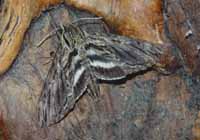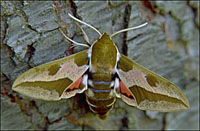Sphingini tribe:
 |
Ceratomia amyntor WO, Elm Sphinx. Four-horned Sphinx:
Brown with dark brown and white markings including white costal area near wing base, dark streaks along veins, and white spot in cell.
Elm (Ulmus), birch (Betula), basswood (Tilia), cherry (Prunus). |
 |
Ceratomia undulosa WO, Waved Sphinx:
Fw upperside pale brownish gray (occasionally dark) with wavy black and white
lines and black-outlined white cell spot. |
 |
Lapara bombycoides BAMONA, Northern Pine Sphinx:
Gray with heavy black bands. Hindwing brownish gray with no markings. If you have pines, you probably have this species.
|
 |
Lintneria eremitus WO, Hermit Sphinx: Fw upperside gray-brown with wavy lines, black dashes, one or two
small white spots near center of costa. Hw upperside: black with two white bands and triangular black patch at base. Note golden hair on thorax.
|
 |
Manduca quinquemaculatus WO, Five-spotted Hawkmoth:
Flies over tobacco fields and vegetable gardens (potatoes, tomatoes) and wherever host plants are found.
possibility |

| Sphinx canadensis WO, Canadian Sphinx:
Uncommon, not often reported anywhere. Larval hosts are white ash (Fraxinus americana) and blueberry
(Vaccinium).
|
 |
Sphinx chersis WO, Northern Ash Sphinx, Great Ash Sphinx:
Soft dark gray to blue-gray with series of black dashes, one of which reaches wing tip. |
 |
Sphinx drupiferarum
WO, Wild Cherry Sphinx
The costal area in the basal and median areas of the forewing is light grey. This colour also
appears in the terminal area. The rest of the wing is dark slatey grey.
|
 |
Sphinx gordius WO, Apple Sphinx:
Highly variable. Fw fringes mostly black with some white; hw fringes mostly white with few black patches.
Fw ranges from brown with black borders to brownish gray with paler borders to pale gray with no borders.
Dashes, submarginal line, cell spot usually weak.
|
 |
Sphinx kalmiae WO, Laurel Sphinx: Forewings predominantly brownish-yellow with fairly wide dark bar
along inner margin. At rest wings hug body, giving moth long slender look.
possibility
|
 |
Sphinx luscitiosa WO, Canadian Sphinx, Clemen's Sphinx:
Fw yellowish gray in males; pale gray with faint yellow tint in females.
Dark border on outer margin widens as it approaches inner margin.
Hw deep yellow in males, pale yellow in females; both with wide black border.
|
 |
Sphinx poecila WO, Poecila Sphinx:
If you have blueberries in the woods, then you probably have the Poecila Sphinx. Probably widespread throughout Wisconsin,
but are very much under reported. |
 |
Sphinx vashti WO, Snowberry Sphinx: Narrow black subterminal line bordered by white inverted V-shaped line on outside,
black line running inwards from apex of wing.
It is most often found in montane woodlands and along streamcourses.
|
Smerinthini Tribe:
 |
Amorpha juglandis WO, Walnut Sphinx:
Highly variable; sometimes wings may be all one color or may have several colors, ranging from pale to dark brown, and may have a white or pink
tinge. See the file for the female; she is different. |
 |
Pachysphinx modesta WO, Modest Sphinx, Poplar Sphinx:
Large poplar/willow feeder with heavy body.
|
 |
Pachysphinx occidentalis WO, Big Poplar Sphinx:
This one is quite similar to Pachysphinx modesta, with modesta being smaller and darker. Moths should be on the wing from June-August.
|
The listing by BAMONA of Pachysphinx occidentalis in Wisconsin (nearby counties) is a surprise as it is generally considered to be a much more western
species, not beginning to appear until the Dakotas.
 |
Paonias excaecata WO, Blinded Sphinx:
Fw outer margin quite wavy. Dark cell spot and dark oblique line mid wing from costa almost to
inner margin. Basic ground colour pinkish brown. Flight would be June-July. |
 |
Paonias myops WO, Small-eyed Sphinx:
This small species ranges across North America. The hindwings have a small blue eyespot ringed with black on a yellow background.
|
 |
Smerinthus cerisyi WO, Cerisyi's Sphinx, One-eyed Sphinx,
Poplars, willows. Flight would be from late May-July as single brood.
Note: lower protion of pale "C" at right forewing apex does not reach outer margin. very questionable.
|
 |
Smerinthus jamaicensis WO, Twin-spotted Sphinx:
Closely resembles cerisyi, but much smaller with larger blue patch (split in two) on more vibrant and deeper purple in lower wings.
|
Macroglossinae subfamily
Dilophonotini Tribe:
See Hemaris comparison to help distinguish the next three species.
 |
Hemaris diffinis WO, Snowberry Clearwing:
Flies along forest edges, meadows, gardens, brushy fields. Day-flying adults nectar at lantana, dwarf bush honeysuckle,
snowberry, orange hawkweed, thistles, lilac, Canada violet, etc. |
 |
Hemaris gracilis WO, Slender Clearwing, Graceful Clearwing:
Day flier not commonly reported. Generally it is reported more to the east. |
 |
Hemaris thysbe WO, Hummingbird Clearwing:
Not difficult to see why many gardeners would mistake this moth for small hummingbird as it hovers, sipping nectar
from flowers through long feeding tube. |
Philampelini Tribe:
 |
Eumorpha achemon WO, Achemon Sphinx:
Adults nectar from flowers of Japanese honeysuckle (Lonicera japonica), petunia (Petunia hybrida), mock orange
(Philadelphus coronarius), phlox (Phlox). |
 |
Eumorpha pandorus WO, Pandorus Sphinx:
If you have Grape or Virginia Creeper nearby, then you probably have pandorus. I often get asked to identify larvae from areas not previously been reported.
achemon and pandorus generally more southerly |
Macroglossini Tribe:
 |
Amphion floridensis WO, Nessus Sphinix:
This day flier is widely distributed. If you have Virginia Creeper, you might have the Nessus Sphinx. Two bright, distinct, narrow
yellow bands are often visible on the abdomen.
|
 |
Darapsa choerilus WO, Azalea Sphinx:
You will often see this species listed as Darapsa pholus,
especially in older literature. |
 |
Darapsa myron WO, Virginia Creeper Sphinx, Grapevine Sphinx:
It is widely reported in southern Michigan and in southern Ontario. It may be present, although unlikely.
|
 |
Deidamia inscriptum WO, Lettered Sphinx:
It is seen in southern Ontario, however, and in central and
southern Wisconsin and usualy more southerly. |
 |
Hyles euphorbiae WO, Spurge Hawk Moth: Body light brown with various white and dark brown
markings, while wings have conspicuous tan, brown, pink or red color pattern.
|
 |
Hyles lineata WO, White-lined Sphinx:
Adults usually fly at dusk, during the night, and at dawn, but they also fly during the day over a wide variety of open habitats
including deserts, suburbs, and gardens. |
 |
Sphecodina abbottii WO, Abbott's Sphinx:
This moth is very much under reported on USGS. It is a rapid day flier so is probably not in too many collections. Grape is a popular larval host.
|
|


































